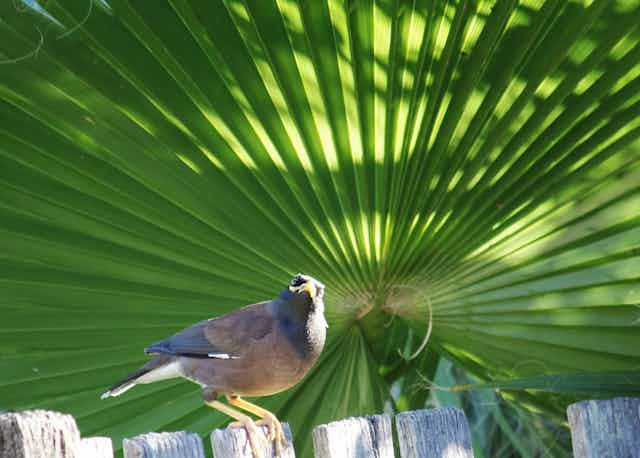In Australia we are all too familiar with devastating environmental impacts of introduced species such as foxes, rabbits and cane toads. But did you know that some introduced species may have a relatively minor environmental impact? In fact, some native species can cause more harm than so called “alien” or introduced species. Perhaps we should not judge a “species on its origins”.
Introduced species can have unpredictable impacts. It is important to ensure we use sound scientific evidence when we develop species management strategies. However, it is often difficult to determine whether introduced species are displacing native species, or whether human changes to habitat are both displacing local species and improving conditions for introduced species. Without rigorous scientific investigation, it’s hard to know what action to take.
But science can take a long time. Meanwhile, there is significant public concern that one invasive species – the common myna – aggressively competes for nest sites (in tree hollows), territory and food with Australian native birds. This behaviour has been widely observed, and the public demands action. Some have even taken matters into their own hands.

In 2005 the Australian community voted the common myna as the top “pest problem that needs more control”. They were more worried about mynas than cane toads, foxes, feral cats and rabbits. Many scientists, on the other hand, question the seriousness of myna impact and the type of management (if any) that is warranted.
Some research suggests that a Common Myna invasion is a symptom of habitat change, that the species takes advantage of the human modified environment and in fact has little impact on native bird species:
The substantial efforts currently directed towards culling of Common Myna in heavily urbanized environments is misdirected, and resources would be better directed to improvement of natural habitat quality in these areas if the purpose of control is to enhance urban bird diversity.
Other work suggests the species could possibly cause native species decline, yet concedes that “few studies that rigorously establish the negative effects of Common Myna on native fauna are available”.
A difference of opinion between scientists and the community may be detrimental. Successful species management requires cooperation among scientists, the government and the community.
The bird we love to hate
It is possible that community members react strongly to the myna because it is a highly visible species in urban areas. Many have also directly witnessed the myna competing with native species. While this can be distressing to observe, aggressive domination of one species by another may not necessarily result in a widespread reduction of the dominated species.
Due to a lack of science and communication, concerned citizens often find information from naturally biased sources. Community groups promoting species management are not bound by the same constraints as science and can make claims about a species impact without the need for extensive studies. Community programs targeting the Common Myna use emotive statements such as “you can have native birds or Indian Mynas … But not both”. This community passion for invasive species management is positive, but it must not cloud rational scientific judgement and the strategic allocation of pest management resources.

So, how should we manage the myna?
The breakdown in communication between science and the community is a barrier to effective invasive species management. Community group leaders often need to take more extreme views of management issues to gain community support, while scientific research takes a long time to produce and is often not accessible to community members.
For example, some community members still believe eradicating a species is the best option. However, many past eradication efforts have been unsuccessful and a waste of resources. For example, 26 of 30 attempted plant eradications in the Galapagos Islands since 1996 have been unsuccessful. In Australia, an expenditure of more than $AUD20M has failed to eradicate cane toads. Now, the focus has shifted from eradication to reducing the species’ impact.
Scientists now aim to better understand species’ impact and how to reduce this impact. However, many community-based management programs still focus on counting the number of animals they have culled. For the successful management of species we need sound science on species’ impacts and how to reduce these impacts. This information then needs to be communicated effectively to the government and the community to help guide successful management.
Recently published research on the long-term abundance of bird species in Canberra by myself and co-authors indicates the myna may be both a symptom of human habitat alteration and the cause of reduced native species abundance.
Given what we’ve seen about how habitat influences species abundance, habitat restoration and tree planting may be a useful management tool. Habitat restoration could help control the abundance of invasive species and aid native species recovery.
Unless we restore habitat and make these areas “less-suitable” for “pest” species, attempts to reduce species numbers are only likely to work in the short-term, with the species re-invading once control actions stop.
Read more - Controlling rabbits: let’s not get addicted to viral solutions.

